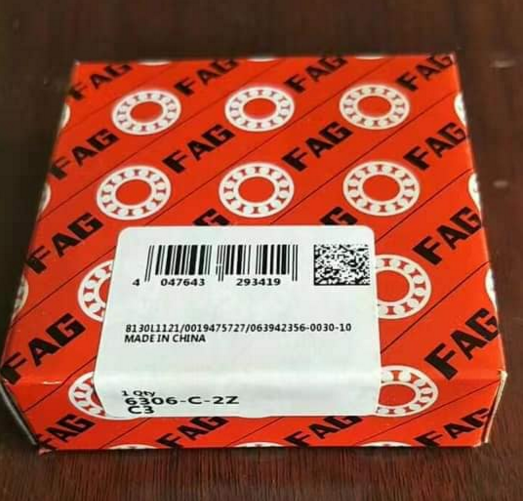
 News
NewsThere are two ways to detect abnormal sound of FAG bearings. One is the noise detection method based on acoustics, and the other is the detection method based on vibration.
1. Detection method of abnormal sound
(1) Noise detection method
In a silencing environment where the basic noise is less than 20db, a high-quality microphone is used to extract the bearing sound pressure signal at a certain distance and direction, and the abnormal sound components are extracted through a certain analysis method. It is a direct measurement method for abnormal sound.
(2) Vibration detection method
It is an indirect detection method of abnormal sound, which can be divided into qualitative detection method and quantitative parameter detection method. Among them, the qualitative detection method is divided into monitoring abnormal sound method and observing vibration waveform method. The quantitative parameter detection method is to use the measured parameter values related to the abnormal sound in the tested bearing vibration signal, such as the peak value of the vibration and the crest factor to evaluate the abnormal sound of the bearing.
(3) Measuring instruments for measuring abnormal sound of bearings
There are many measuring instruments for measuring abnormal bearing sound. These bearing measuring instruments can measure the effective value of bearing vibration and also measure the peak value, crest factor and pulse number reflecting the abnormal bearing sound parameters.
Click here for more details about FAG Bearing 6306-C-2Z-C3.

2. Vibration signal analysis and diagnosis
FAG bearing vibration is very sensitive to bearing damage, such as peeling, indentation, corrosion, cracks, wear, etc., will be reflected in the bearing and vibration measurement. Therefore, by using a special bearing vibration measuring device (frequency analyzer, etc.), the magnitude of the vibration can be measured, and the specific abnormal situation can be inferred from the frequency distribution. The measured value varies depending on the use condition of the bearing or the installation position of the sensor, so it is necessary to analyze and compare the measured value of each machine in advance to determine the judgment standard.
There are many kinds of FAG rolling bearing fault detection and diagnosis technologies, such as vibration signal detection, lubricating oil analysis and detection, temperature detection, acoustic emission detection, etc. Among the various diagnostic methods, the vibration signal-based diagnostic technology is the most widely used. The technology is divided into two types: simple diagnostic method and precise diagnostic method. Simple diagnosis uses various parameters of the vibration signal waveform, such as amplitude, form factor, crest factor, probability density, kurtosis coefficient, etc., as well as various demodulation techniques to make preliminary judgments on the bearing to confirm whether there is a fault; precise diagnosis uses Various modern signal processing methods determine the fault category and cause of the bearing that is considered to be faulty in the simple diagnosis.
3. Acoustic emission detection
The principle of acoustic emission detection technology is that when materials are deformed or cracked by external or internal forces, the phenomenon of releasing strain energy in the form of elastic waves is called acoustic emission.
The technology of using instruments to detect and analyze acoustic emission signals and use acoustic emission signals to infer the source of acoustic emission is called acoustic emission detection technology, which uses the phenomenon that particles within a substance release strain energy in the form of elastic waves due to relative motion to identify and understand substances Or the internal state of the structure.
Acoustic emission signals include burst type and continuous type. The burst acoustic emission signal consists of pulses that are distinguished from the background noise and can be separated in time; the single pulse of the continuous acoustic emission signal is indistinguishable. In fact, continuous acoustic emission signals are also composed of a large number of small burst-type signals, but they are too dense to distinguish. In the case of poor running of rolling bearings, both sudden and continuous acoustic emission signals may be generated. The relative movement between the contact surfaces of the various components of the bearing (inner ring, outer ring, rolling element and cage), Hertz contact stress caused by rubbing, and surface cracks, wear, indentation, etc. due to failure, overload, etc. Faults such as grooving, occlusion, poor lubrication caused by rough surface, surface hard edges caused by lubricating pollution particles, and pitting caused by current passing through the bearing, all produce sudden acoustic emission signals.
The continuous acoustic emission signal mainly comes from poor lubrication (such as the failure of the lubricating oil film, the immersion of pollutants in the grease), which leads to the oxidation and wear of the bearing surface, resulting in global faults, excessively high temperatures, and frequent occurrence of local bearing faults. These factors result in a large number of sudden acoustic emission events in a short period of time, resulting in continuous acoustic emission signals. During the operation of the rolling bearing, its failure (whether it is surface damage, crack or wear failure) will cause the elastic impact of the contact surface to generate an acoustic emission signal. This signal contains a wealth of rubbing information, so acoustic emission can be used to monitor and Diagnose rolling bearing faults.